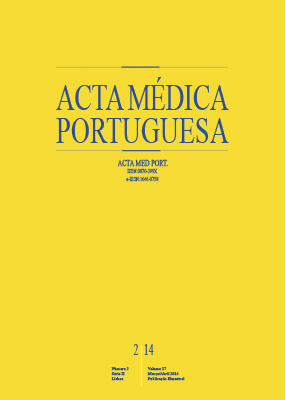Brucellar Spondylodiscitis: Case Series of the Last 25 Years
DOI:
https://doi.org/10.20344/amp.4117Abstract
Introduction: Brucellosis is an endemic zoonosis in Portugal. Brucellar spondylodiscitis is one of the most frequent focal manifestations which may cause severe sequelae despite appropriate therapy.Material and Methods: Retrospective study of patients with diagnosis of brucellar spondylodiscitis admitted to the Infectious Diseases Department of Centro Hospitalar e Universitário de Coimbra, over a 25-year period (1988-2012).
Results: We identified 54 patients, 55.6% male, mean age of 54.8 years. In 81.5% an epidemiological context was identified, mostly contact with sheep and goats. The duration of symptoms prior to diagnosis was 5.5 months. The most common signs and symptoms were pain (98.1%), fever (46.3%) and neurological deficits (25.9%). Spinal magnetic resonance imaging was the most used imaging method (77.8%) showing abscesses in 29.6% of patients. Lumbar location predominated (77.7%). Diagnosis was attained in 47 patients (87.0%): positive blood cultures (3 patients), positive serology (32 patients) or by both methods (12 patients). Combined regimens of doxycycline and rifampicin (64.8%), or streptomycin (24.1%) were most used, for an average duration of 4.4 months. A patient was referred for surgery for abscess drainage. Evolution was mostly favorable (92.6%), no deaths occurring.
Discussion: Research of the epidemiologic context turned out to be a major key leading to the diagnosis. Treatment of osteoarticular brucellosis is still controversial.
Conclusions: Brucellar spondylodiscitis should be considered in the differential diagnosis of patients with low back pain, even in the absence of fever, particularly in regions where the disease is endemic. Antibiotic regimen, its’ duration and the need for surgery should be individualized to achieve a better prognosis. Cases have declined over the years, a fact related to better control of animal endemic.
Downloads
Downloads
Published
How to Cite
Issue
Section
License
All the articles published in the AMP are open access and comply with the requirements of funding agencies or academic institutions. The AMP is governed by the terms of the Creative Commons ‘Attribution – Non-Commercial Use - (CC-BY-NC)’ license, regarding the use by third parties.
It is the author’s responsibility to obtain approval for the reproduction of figures, tables, etc. from other publications.
Upon acceptance of an article for publication, the authors will be asked to complete the ICMJE “Copyright Liability and Copyright Sharing Statement “(http://www.actamedicaportuguesa.com/info/AMP-NormasPublicacao.pdf) and the “Declaration of Potential Conflicts of Interest” (http:// www.icmje.org/conflicts-of-interest). An e-mail will be sent to the corresponding author to acknowledge receipt of the manuscript.
After publication, the authors are authorised to make their articles available in repositories of their institutions of origin, as long as they always mention where they were published and according to the Creative Commons license.









